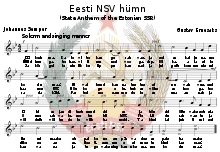Anthem of the Estonian Soviet Socialist Republic
The "State Anthem of the Estonian SSR"[lower-alpha 1] was the regional anthem of the Estonian Soviet Socialist Republic (under the Soviet Union) from 1945 to 1990.
| English: 'State Anthem of the Estonian SSR' | |
|---|---|
 | |
Regional anthem of the | |
| Lyrics | Johannes Semper |
| Music | Gustav Ernesaks |
| Adopted | 20 July 1945[1] 21 July 1956 (modified version) |
| Relinquished | 8 May 1990[2] |
| Succeeded by | Mu isamaa, mu õnn ja rõõm |
| Audio sample | |
State Anthem of the Estonian SSR (1945 version)
| |
During the decades of the Soviet occupation of Estonia, the official Estonian anthem was strictly forbidden. Throughout the years of prohibition, Lydia Koidula's poem, Mu isamaa on minu arm, with a melody by Gustav Ernesaks served as means of expressing national feelings, and was regarded as an unofficial anthem of Estonia. With the restoration of Estonian independence in 1991, the official national anthem from 1920 by Fredrik Pacius with lyrics by Johann Voldemar Jannsen was restored.[3]
Along with the Anthem of the Armenian SSR, it is one of the only two SSR anthems without an intro.
Background
The anthem was presented to the government of the USSR on May 1944, three months after the decree of the Presidium of the Supreme Soviet of the USSR on February 3, 1944, "On the State Anthems of the Soviet Republics." [4]
The music of the Estonian Soviet Socialist Republic's anthem was composed by Gustav Ernesaks, and the lyrics were written by Johannes Semper. It, the anthem of the Karelo-Finnish SSR, and the anthem of the Georgian SSR were the only ones not to mention the Russian people. When Stalin died in 1953, during the De-Stalinization, the State Anthems were muted by Nikita Khrushchev alongside with the ESSR Anthem. On July 21, 1956, the third stanza of the lyrics was changed to remove mentions of Joseph Stalin.
Lyrics
I |
I /jɑ seisɑ kɑljunɑ | me kodumɑː/ /ei ʋɑibund kɑnːɑtustes sinu ʋɑhʋus/ /sirp | lɤikɑ | ɑlɑsile | hɑːmer | løː/ /nɤukogu elu | tuksu ʋɤimsɑ hoːgɑ/ /toː ɤnːe rɑhʋɑle | me tubli tøː/ /me liːdu rɑhʋɑste jɑ riːke seɑs/
/me ʋɤitlusʋɑim jɑ kohkumɑtu mehemeːl/ |
I |
Notes
- Estonian: Eesti Nõukogude Sotsialistliku Vabariigi hümn; Russian: Гимн Эстонской Советской Социалистической Республики, romanized: Gimn Estonskoj Sovetskoj Socialističeskoj Respubliki
- See Help:IPA/Estonian and Estonian phonology.
References
- "Eesti NSV hümn". Postimees. Retrieved 10 March 2017.
- "Seadus Eesti sümboolikast". Riigi Teataja. Retrieved 10 March 2017.
- "National anthem of the Republic of Estonia". eesti.ee. Retrieved 4 September 2017.
- "National anthem of the Republic of Estonia". news.tut.by. Retrieved August 2, 2018.
- "Postimees (1886-1944), nr. 170, 24 juuli 1945". dea.digar.ee.
- "The Estonian Soviet Socialist Republic Anthem". Marxists.org. Retrieved 2020-04-22.
